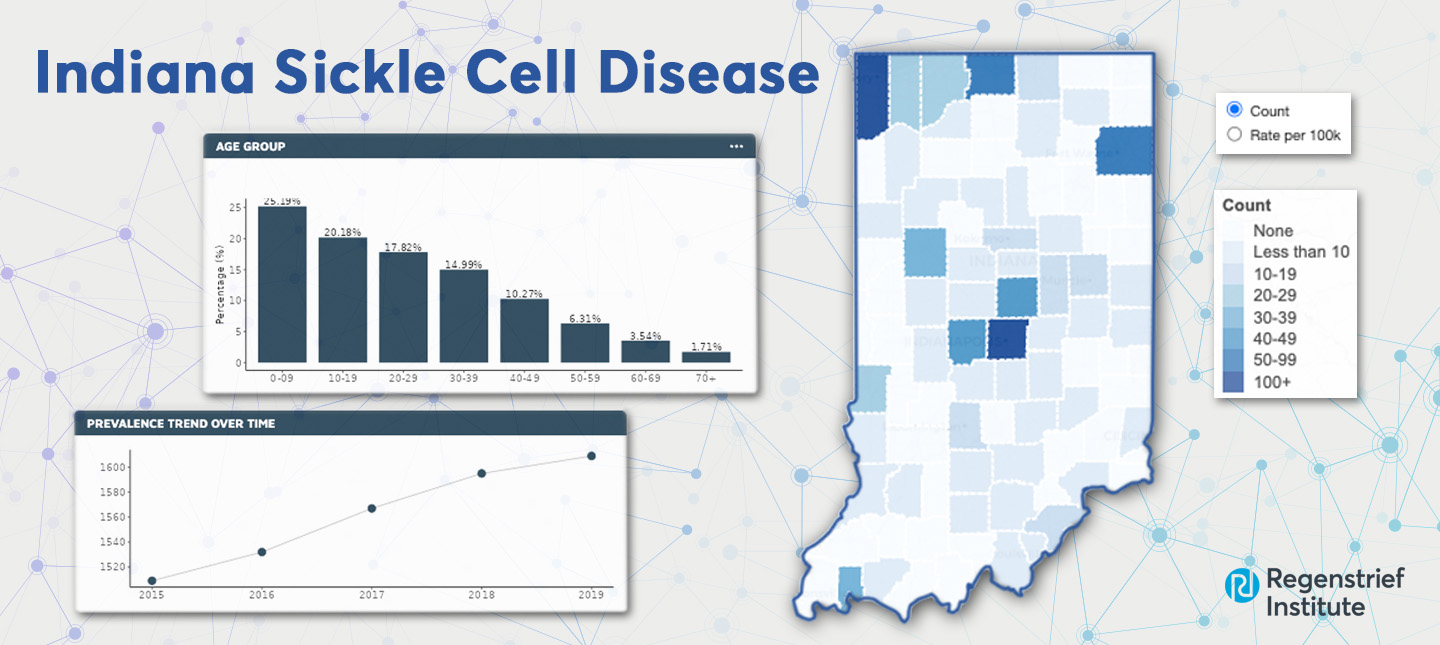The Indiana Sickle Cell Dashboard, launching this month on the Regenstrief Institute website, presents a dynamic, panoptic picture of sickle cell disease throughout an entire state. The new dashboard uses de-identified data from throughout the state of Indiana, obtained from multiple clinical and administrative sources, to present easy-to-understand, interactive visualizations of the disease’s prevalence and burden.
The pioneering dashboard, created, developed and maintained by the Regenstrief Institute, is one of the first to present such a comprehensive view of the impact of the disease. The project is supported by the Centers for Disease Control and Prevention (CDC) and will be officially presented at the CDC’s 2024 sickle cell data collection summit this summer.
The unique aggregation of data offers visitors a state overview and the ability to drill down by county to see how many people are living with sickle cell disease, highlighting pockets of disease. It also presents rates per 100,000 population, a standardized measure that can be used to compare sickle cell populations between states or areas around the world. In contrast to charts with rows of numbers, the dashboard’s dynamic visualizations make numbers and trends easy to interpret.
The sickle cell dashboard provides de-identified information on individuals from several perspectives. It shows data on individuals diagnosed with the disease and in treatment as well as those known not to be in treatment, chronic health conditions (comorbidities), as well as death rates throughout the state and by county.
Drawing upon extensive expertise in clinical and population health informatics and the lessons learned from the design, development and maintenance of the highly cited Regenstrief COVID-19 dashboard, an institute team designed, developed and will maintain the comprehensive sickle cell dashboard with the needs of the end user in mind. End users include the public (among them individuals living with sickle cell disease), primary care clinicians, specialist physicians treating the disease as well as public health officials engaging in disease surveillance and securing federal or other funds to support this work.
“Much of the data out there today at the national level or sometimes at the state level are estimates based on the number of people who are newly born with sickle cell disease rather than really measuring all the people living with sickle cell,” said Regenstrief’s interim director of the Center for Biomedical Informatics Brian Dixon, PhD, MPA, who leads the dashboard initiative. “The new dashboard brings data to life. It provides a more comprehensive picture of those living with sickle cell in the state and the data are at a level where it prevents patient re-identification and at the same time, enables us to aggregate it to be useful for population health.”
Dr. Dixon notes, that “unlike COVID where you had an emergent condition and everyone wanted to know yesterday’s numbers today, sickle cell is a chronic illness and there’s not a need for daily updates.”
The Indiana Sickle Cell Dashboard will be updated twice a year, with the release of new data coordinated with the timing of data collection by the Indiana Department of Health. These data will be combined with Medicaid data from the Indiana Department of Family and Children’s Services and clinical data from the Indiana Hemophilia and Thrombosis Center and the Indiana Network for Patient Care (INPC). INPC, created by Regenstrief Institute and now managed by the Indiana Health Information Exchange, is one of the nation’s largest inter-organizational clinical and claims data repositories, containing more than 16 billion clinical data items.
Sickle cell disease, the most common inherited blood disorder in the United States, is a lifelong illness. Individuals living with sickle cell disease can have episodes of extreme pain known as pain crises. They are also at an increased risk of stroke and other serious medical problems. The first gene therapies for patients with sickle cell disease were approved by the U.S. Food and Drug Administration (FDA) in December 2023.
In the U.S., most people who have sickle cell disease are of African ancestry or identify themselves as Black. According to the National Institutes of Health, about 1 in 13 Black or African American babies carry the sickle cell trait and 1 in 365 are born with sickle cell disease. Sickle cell disease is a major public health challenge in much of Africa, with Nigeria having the most cases on the continent and in the world.
June 19 is officially designated as World Sickle Cell Awareness Day. This year’s theme is “Hope Through Progress: Advancing Care Globally.”
Members of the Institute dashboard team, in addition to Dr. Dixon, include Heather Taylor, PhD, MPH, RDH; Jennifer Crago, M.S.; Mengyu Di, MSPH; Gerard D. Hills, M.D.; Jennifer Gatz, PhD; Zach Carr, MBA and Muchiri Wandai, PhD, MSc.
The Indiana Sickle Cell Disease Dashboard can be found here: https://www.regenstrief.org/sickle-cell-dashboard/
Brian E. Dixon, PhD, MPA
In addition to his role as the director of public health informatics at the Regenstrief Institute and Indiana University Richard M. Fairbanks School of Public Health, Brian E. Dixon, PhD, MPA, is the interim director and a research scientist with the Clem McDonald Center for Biomedical Informatics at Regenstrief Institute and a professor of epidemiology at the Fairbanks School of Public Health. He is also an affiliate scientist at the U.S. Department of Veterans Affairs Health Services Research and Development Center for Health Information and Communication, Richard L. Roudebush VA Medical Center.










